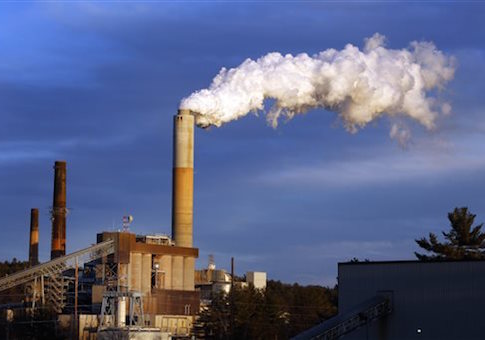Environmental activists working to influence the Obama administration’s sweeping new carbon regulations have colluded for years with officials at the Environmental Protection Agency (EPA), according to a report released Tuesday by the Republican majority of the U.S. Senate Committee on Environment and Public Works.
The report documents the extent to which activists—particularly those at the National Resources Defense Council (NRDC)—maintained access to officials via email and closed-door meetings and were thus able to feed information to the administration and steer its messaging regarding the regulations, announced Monday, on greenhouse gas emissions from new and existing power plants.
The committee report comes just days after Obama championed the new regulations as "the biggest most important step we’ve ever taken to combat climate change," and more than two years after the president ordered the EPA to develop such rules for power plants under the Clean Air Act.
According to the report, EPA officials routinely corresponded via email with NRDC leaders with whom they also held meetings away from government property, thereby evading transparency requirements, since the start of the rule making process for the power plant regulations in March 2011.
In fact, a meeting was scheduled between NRDC officials and now-administrator of the EPA Gina McCarthy, then assistant administrator for the agency’s Office of Air and Radiation, a mere eight days after the power plant regulation development process began. The rendezvous appeared to be in response to a request from David Doniger, NRDC senior attorney and a former Clinton administration official, to whom McCarthy once promised over email she would "never say no to a meeting."
Doniger consistently corresponded with EPA officials between 2011 and 2014 regarding the power plant regulations, sometimes engaging in secretive meetings with McCarthy or other officials at locations outside of EPA headquarters, such as a Starbucks in a nearby Marriott and a Washington park.
When NRDC activists were not meeting face-to-face with EPA officials, they were corresponding with them via email. Doniger repeatedly fed the EPA information in the form of Powerpoint presentations and other tools they could use when crafting the power plant regulations.
In a detail that echoes the timely controversy surrounding former Secretary of State Hillary Clinton’s use of a private email, the report reveals that EPA officials sometimes employed personal email accounts to communicate with NRDC activists.
In fact, one former EPA official Michael Goo, who served as associate administrator for the EPA Office of Policy from 2011 to 2013 and previously worked as a registered lobbyist for NRDC, on multiple occasions used a personal Yahoo! email account—messages from which were not archived on government servers, a violation of the Federal Records Act—in correspondence with the NRDC.
Goo on at least one occasion also went behind McCarthy’s back to advocate for suggestions for the power plant proposal from the NRDC.
The report documents not only the frequency of communication between environmental groups and EPA officials but also activists’ scope of influence on the Obama administration throughout the development of the power plant regulations and accompanying messaging.
In an email sent to colleagues in 2012, McCarthy wrote of a White House call with environmental activist groups regarding the need to "control the message" on the EPA’s proposed rule for new power plants, days after which visitor logs indicate that leaders from both the Environmental Defense Fund and the Sierra Club met with the president.
The EPA also hosted a meeting at its headquarters in July 2013 with the NRDC and other activist groups to "inform and lay out the process for engagement" regarding Obama’s executive action requiring the EPA to issue its proposals for new and existing power plants the same year.
The record of the meeting, to which Doniger was invited, indicates that environmental activists and EPA officials coordinated to develop talking points and messaging regarding Obama’s directive and the EPA’s development of the power plant regulations.
The Senate committee report, which spans communication between EPA officials, the NRDC and other groups through the agency’s release of its proposed existing power plant regulations in June 2014, demonstrates the degree to which climate change activists have aided the Obama administration in its effort to push the regulations outlined by the president during remarks at the White House Monday.
During a call with reporters the same day, senior counsel for the EPW said the report could have legal implications for the EPA, given the level of cooperation between the administration and environmental activists and the resulting lack of transparency regarding the process.
Many lawmakers have expressed outrage at the regulations, and some states are vowing to sue the administration over the EPA rules, which McCarthy has said will cost $8.4 billion.
